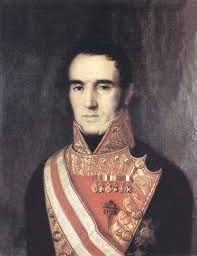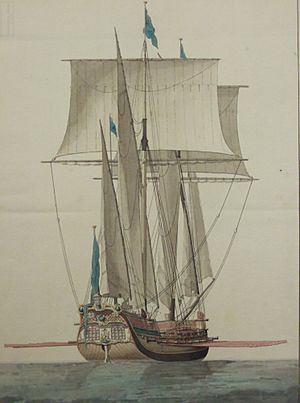Enrique MacDonell facts for kids
Quick facts for kids
Minister of the Supreme Council of the Admiralty
Enrique MacDonnell
|
|
|---|---|

Portrait of Enrique MacDonnell
|
|
| Born | 1753 Pontevedra, Spain |
| Died | 23 November 1823 Cadiz, Spain |
| Allegiance | Spanish Empire Sweden |
| Service/ |
|
| Years of service | 1776 – 1823 |
| Rank | Vice-Admiral |
| Commands held | Santa Ana, Andaluz, Diligencia, Santo Domingo, Oden,San Felipe Apolstol. Astudo, Gallardo, SanCarlos, San Nicholas de Bari, Rayo |
| Battles/wars | American Revolutionary War
|
Enrique MacDonnell (also spelled MacDonell) was a famous Spanish admiral. He is well-known for fighting in many important sea battles, including the Battle of Trafalgar.
He was born in Pontevedra, Spain, in 1753. His family was a mix of Irish and Spanish heritage, and they were quite important. His father was a high-ranking officer in the Spanish Army. His mother was a lady-in-waiting for the royal family. Even though he was born in Spain, some naval records incorrectly listed him as Irish.
Contents
MacDonnell's Family Roots
Enrique MacDonnell's family had strong Irish connections. His grandparents were from Dublin and Cork in Ireland. They moved to Spain to escape difficult times in Ireland. This explains why he was sometimes listed as Irish, even though he was born in Spain.
Following his family's tradition, Enrique first joined the Spanish Army when he was only 7 years old in 1760. He quickly moved up the ranks, becoming a second lieutenant in 1764 and a captain in 1774.
In 1775, he was made a Knight of the Order of Santiago, a special honor. The next year, in July 1776, he decided to switch to the Spanish Navy.
MacDonnell had an impressive career in the navy. He traveled a lot and commanded ships in famous battles like the Battle of Roatan and the Battle of Trafalgar. He was injured a few times but steadily rose from a sub-lieutenant to a vice-admiral.
One of his first missions was against the Algerians in 1776. He was on the frigate Gaviota and later the 34-gun frigate Carmen. In November, his ship helped burn two enemy ships.
In 1777, he became a lieutenant and commanded the xebec Pilar. He sailed to Corsica and the West Indies. During this time, he was injured in a fight with a larger English ship.
In 1779, he was on the 34-gun frigate Santa Maria Magdalena. They were looking for English ships near the Azores. On September 11, they chased an English ship, but it got away in the dark. Later, on August 15, 1779, his ship captured a British privateer (a private ship allowed to attack enemy ships) called Duke Of Cornwall. They tricked it by pretending to be a merchant ship.
In 1780, MacDonnell was on the ship Andaluz, helping to transport troops to Havana, Cuba.
Fighting in the American Revolutionary War
In April 1781, he joined the 74-gun ship San Gabriel. He took part in the Siege of Pensacola, where he went ashore with marines and was wounded. After recovering, he was promoted and given command of the sloop Santa Ana.
MacDonnell was one of the leaders in the Battle of Roatán in March 1782. He was second-in-command on the 40-gun Santa Matilde. When the British soldiers on the island refused to give up, MacDonnell, who spoke English and French, was chosen to go ashore and offer them terms of surrender. They refused, so the Spanish attacked and took control of the island.
Later, he helped take control of other British settlements along the coast of Honduras. He was promoted to full captain on June 23, 1782.
In February 1783, he commanded the corvette Diligencia. On December 4, his ship fought a strong English privateer north of Bermuda and sank it.
In 1789, MacDonnell joined the Swedish Navy to fight in the Russo-Swedish War. He commanded the ship Oden. During the 1789 Battle of Svensksund, he fought a long cannon battle against several Russian ships. He was badly injured and had to surrender after being surrounded by seven enemy ships. He became a prisoner of war in St Petersburg.
After he was released, Gustav III of Sweden honored him for his bravery. He was even offered command of the entire Swedish Navy, but he turned it down. One reason was that his release from Russia came with a condition: he could not fight against Russia again. The King of Spain agreed with his decision. MacDonnell continued to advise the Swedish king on naval matters.
Return to Spanish Service
In July 1791, MacDonnell returned to Spain. He commanded the 68-gun ship San Felipe Apostol off the coast of Morocco.
From May to August 1793, he was captain of the 60-gun Astuto. He sailed with a large fleet that captured the islands of San Pietro and Sant'Antioco in Sardinia. The French soldiers there surrendered without a fight.
In January 1794, he was promoted to commodore. He commanded the 94-gun San Carlos, sailing to Havana and the Sea of the Antilles. He returned to Cadiz in April 1795 with valuable cargo.
In May 1795, he briefly commanded the 80-gun San Nicholas de Bari.
Retirement and the Battle of Trafalgar
In 1801, MacDonnell retired from the navy. However, he wrote a plan in 1804 for a possible war and invasion of the United States. Spain was worried about the growing power of the United States. This plan was later put aside because of other wars, especially when France destroyed the Spanish naval fleet in 1808.
In 1805, MacDonnell came out of retirement to rejoin the navy. He fought in the famous Battle of Trafalgar, commanding the 100-gun ship Rayo.
Before the Battle
Before the battle, a meeting of the top French and Spanish admirals was held on the French commander's ship. MacDonnell, who spoke French, was one of the senior Spanish officers at this meeting. It was a very heated discussion.
Despite warnings from the Spanish, the French commander, Pierre-Charles Villeneuve, decided to sail out on October 21. As they left port, they met Horatio Nelson's British fleet, and the Battle of Trafalgar began.
During the Battle
During the battle, Rayo was at the back of the fleet. Because the wind was weak, it was hard for Rayo to turn and join the fight. However, MacDonnell ignored orders from the French commodore and was one of only two ships from the rear that turned back to help the main battle.
Rayo had four sailors die and its mast was badly damaged. After the battle, Rayo managed to escape capture. MacDonnell was the highest-ranking Spanish officer to survive the battle unharmed and return to Cadiz. He was promoted to rear-admiral on November 8.
The Trafalgar Rescue Mission
On October 22, the day after the battle, a meeting was held in Cadiz. The Spanish decided to try and rescue the Spanish and French ships that the British had captured. These captured ships had thousands of prisoners on board. MacDonnell was given command of this rescue mission.
On October 23, five Spanish ships set out. Their goal was to surprise the British and get the captured ships back. The British ships were forced to let go of four captured ships and get ready to defend themselves. The Spanish rescue fleet took control of two of the freed ships. The crews on two other ships fought back against their British captors and sailed away.
The mission was considered a success, even though two of the rescue ships, including Rayo, sank in a storm. Two recaptured ships reached Cadiz safely, and the crews of other ships were saved. Most importantly, Vice-Admiral Álava's flagship, Santa Ana, was recaptured.
The British lost four captured ships and 3,000 prisoners. They also lost 150 of their own sailors who were captured by the rescue crews. This forced the British to negotiate a prisoner swap. MacDonnell, who had been captured by the British ship HMS Donegal, was released in these negotiations a week after the battle. Both sides treated their prisoners, especially officers, very well. MacDonnell was even able to write a full report to his admiral while on board the British ship.
Captured by HMS Donegal
When Rayo was captured on October 25, all three of its masts were broken, so it couldn't fight back. MacDonnell surrendered after the first cannon shot. He threw the ship's secret signal book into the sea. A British crew from HMS Donegal took control of the damaged Rayo, and MacDonnell became a prisoner on Donegal.
Despite the British crew's efforts, Rayo sank on the rocks in the storm, and 25 lives were lost. The remaining crew and 25 British sailors were rescued by small Spanish boats. MacDonnell was treated well on Donegal and was released after a week.
War with France and British Alliance
In 1808, when Spain rose up against the French, MacDonnell was put in charge of the Spanish fleet in Cadiz. His first job was to meet the British fleet and declare that Spain was now allied with Britain against France. He refused British help in attacking the French ships in the port, wanting the Spanish to do it themselves. The Spanish attacked the French fleet, and after five days, the French surrendered.
MacDonnell then helped make sure Spain and Britain became strong allies. He was even offered a job as an ambassador in London, but he refused. He said it was not right for a high-ranking officer to take a diplomatic job when his country was at war.
In 1817, he was promoted to vice-admiral and became a Minister of the Supreme Council of the Admiralty. In 1820, MacDonnell helped stop a mutiny (a rebellion) in Cadiz.
Later Life and Death
Enrique MacDonnell became ill and had to go to the hospital in Cadiz. He died there on November 23, 1823. His funeral was paid for by public donations, which showed how much people respected him.
Popular Culture
- The ship Rayo was featured on a Cuba stamp in 1989.
- The remains of Rayo were found in 2003 by a team from the University of Huelva. They were about 300 meters from shore in 7 meters of water. Not much is left today because the site has been explored many times over the years.
Images for kids
See also
 In Spanish: Enrique Macdonell para niños
In Spanish: Enrique Macdonell para niños




